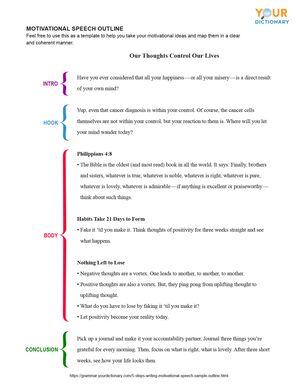

Who doesn't love a little pick me up or a dash of inspiration? When we're feeling low, a small bout of motivational medicine can be enough to lift someone up and out of their slump. If you've been tasked with this wonderful opportunity, we hope these five steps for how to write a motivational speech help you draw in the crowd and start changing lives, one truth at a time.
1. Be Clear About Your Message
Have you ever listened to someone deliver a speech and, although they were quite affable, wondered, "What in the world are they even talking about?" It might've felt disjointed or like they were moving all over the map. The problem there is that they probably weren't super clear themselves about the message they wanted to deliver. So, the first step for writing a motivational speech is to have a clear and concise message.
Create a Central Theme
You might compare it to the thesis statement of an essay. It's one sentence that defines the entirety of everything else that's to come. If you can focus on that one, central theme, you can direct every ensuing point back to that main motivational idea.
If you consider some of the most famous motivational speakers in the world, you'll note that every one of their speeches has one central theme. They don't speak on multiple topics within singular speeches; they focus on one powerfully potent thought. Tony Robbins has been transforming lives for years. Look at his catalog of videos to see how he uses one compelling message per video.
2. Start With a Bang
Of all the components of a speech, your opening lines are the most important. A good hook is absolutely crucial to your success. You may be likable. You may have great energy. But if you don't say something to perk up the ears in the crowd, you'll have lost them even before you've begun.
To help with this, check out how to write a hook. It'll reemphasize the power of the hook and helps you draft your own.
3. Share Narratives
There are a few ways to connect with your audience. The first is eye contact. As you move around the room, it's important to continually scan the crowd and make the audience feel like you're speaking to them directly.
Once you make that connection, share a personal narrative or two. Think of it as a conversation between friends. We're all interrelational on one level or another. Sharing a personal narrative helps you forge that connection in a way straightforward facts and figures cannot.
Consider these narrative essay examples. Although they're intended for the written word, you can see how one moving snippet is enough to move an entire audience.
4. Keep the Audience in Mind
If you consider the word "motivate," it implies action of some sort. This means your motivational speech can't be self-focused. Rather, you have to be the driving force that motivates the audience to some sort of action. Consider your speech as a two-way street. Ask rhetorical questions when possible.
Simply put, you never want to just focus on yourself, your testimony or your narratives. Instead, you want to keep the audience as your primary focus.
- Will they understand what you're saying?
- Can they relate to your narratives?
- Are you providing them with enough examples to encourage them to go out and make a change?
As an added bonus, keeping the focus on them (and not on you) will help keep your nervousness at bay. For more on this, check out these tips on speech writing. They'll help you stamp down any anxieties you may be having and organize a compelling speech.
5. Conclude With a Compelling Thought
Like the hook, how you close is also important. Humans are so fickle and distracted; it's possible your audience will walk out of the room and forget everything you just said.
But, you can stay with them if you can close in a manner that lingers in their mind.
- Ask them to take some sort of action.
- Ask them to step outside their busy lives and do something peculiar to them.
- Ask a rhetorical question that they can answer within their own minds.
A motivational speech is a persuasive speech. You want to foster some type of positive change. To help you along, check out these steps for writing a persuasive speech. They'll help you pull all your thoughts together into a cohesive, yet compelling, train of thought.
Motivational Speech Example
Who among us doesn't ponder the meaning of life from time to time? Where we have been and where we will be in the future is pivotal to our growth. Steve Jobs explored this in his motivational speech at the Stanford Commencement Address.
"Your time is limited, so don’t waste it living someone else’s life. Don’t be trapped by dogma — which is living with the results of other people’s thinking. Don’t let the noise of others’ opinions drown out your own inner voice. And most important, have the courage to follow your heart and intuition. They somehow already know what you truly want to become. Everything else is secondary."
As you watch Job's speech, you'll note he ends with a call to action, "Stay Hungry. Stay Foolish". Those final words will stick with people and likely propel them toward some sort of action.
Motivational Speech Outline Example
For more on how to structure your speech, consider emulating the outline below. Use it as a template to help you gather your thoughts and make major waves.

How to Write a Motivational Speech
Wherever you go, you can choose to be the light in the room. Spread positivity. Let people know they can achieve their life's mission. Best of all, you don't have to toil over what to say. Just choose one thing and build out from there. The less your speech resembles a spider web, the more people you'll touch.
To help you stay on track, take a look at these quick keyword outline examples. A keyword outline will be your best friend when you're up there on the stage. It's a reassuring little piece of paper that lets you know you are, indeed, motivating the crowd.